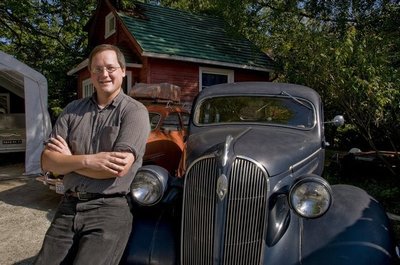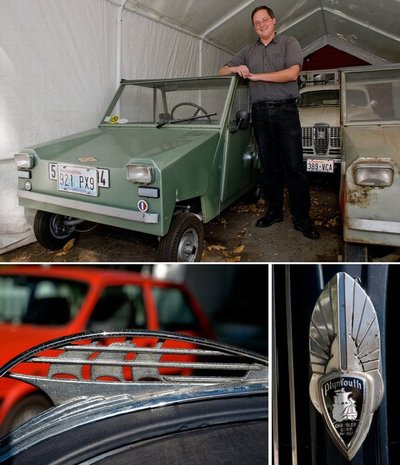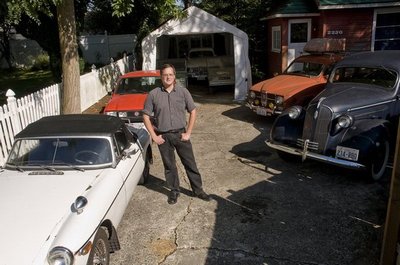October 15, 2009
An ‘accumulation’ of old cars — starring a 1937 Plymouth sedan
By Peter Kelley
University Week
Mike Harrell says he doesn’t collect cool old cars, exactly — it’s more that he accumulates them. And he has quite an accumulation.
You might have seen Harrell, a lecturer and lab manager in Earth and space sciences, driving onto campus in a blue 1937 Plymouth sedan, an off-white 1974 “and a half” MGB or a wacky French “micro car” so minimal it’s barely roadworthy.
Harrell has eight cars in all, the Plymouth the oldest. He said he doesn’t restore them so much as maintain them mechanically — and then, well, he drives them.
“I’ve always preferred older cars. It runs in the family, I suppose.” His father worked as a mechanic in the Army and a few years afterward. “So that’s just how things went, everybody was raised working on cars.”
Harrell has never bought a new or late-model car and never plans to. “I believe the (’82) MG Metro I bought a few months ago is the newest car I’ve ever owned,” he said.
The four-door Plymouth would be at home on a gangster movie set with its long, sleek lines and art deco chrome hood ornament. Harrell said he saw the car for sale on the street in the Roosevelt area about six years ago and bought it straightaway.
It needed work, though. He switched out the engine for another one that had been rebuilt in the 1970s but never used. “I got that for cheap so I had to tear it apart to make sure that everything survived. One of the valves was rusted from sitting for decades but it was far cheaper than rebuilding.” He rebuilt the transmission, rear end and brakes.
“It was essentially a rolling effort, it was never off the road for any significant amount of time,” he said. “And it’s been my daily driver ever since.”
Harrell also has a couple of little 1967 Saabs and a 1959 Ford that’s currently disassembled. He rotates his commuting through his three-car “driving accumulation”: the Plymouth, the 1974-and-a half MGB — the half because it was during a midyear transition from chrome bumpers to rubber — and surely his oddest car, the French KV Mini 1, which looks almost like an oversized toy.
“It’s a tiny little thing,” he said. “I recently took it to a show in Monterey, Calif., and it took Worst of Show, which was the top honor. The show was called the Concours d’LeMons” (“Celebrating the oddball, mundane and truly awful of the automotive world,” according to the Web site. Learn more here: http://www.concoursdlemons.com/).
Oddball is right. The KV is, he said, “a one-cylinder, two-stroke car, 125 ccs, driven by a series of pulleys and a belt that rubs rollers against the tires. That’s what propels it. It’s a very unusual vehicle.” He has a second one he uses for parts; he owns two of the only three KV Mini1’s in the country.
Still, isn’t it unsafe for him to propel himself to and from his Shoreline-area home in such a thing, or a 71-year-old Plymouth for that matter? Harrell smiled. “Unsafe? Well, what isn’t unsafe?”
Of the Plymouth, a behemoth of a car, he said, “It’s sufficiently safe. It doesn’t have any seat belts — it’s exempt, it was manufactured without them. And they wouldn’t necessarily be all that meaningful anyway because the rest of the car isn’t constructed for that. They would largely be a cosmetic concession.”
Harrell got the original papers when he purchased the car. “It’s been in Seattle since 1937 … it was bought downtown.”
A three-speed, manual of course, the sedan cruises comfortably at 60 to 65 miles an hour and has proved to be reliable transportation. “Most of my family lives in Southern Oregon and I drive back and forth to visit them,” he said. “I hope to keep it on the road for a few more years.”
One thing though — the old Plymouth was manufactured without turn signals.
“I have to use hand signals,” Harrell said. “But people don’t recognize hand signals. They generally just wave back.”



